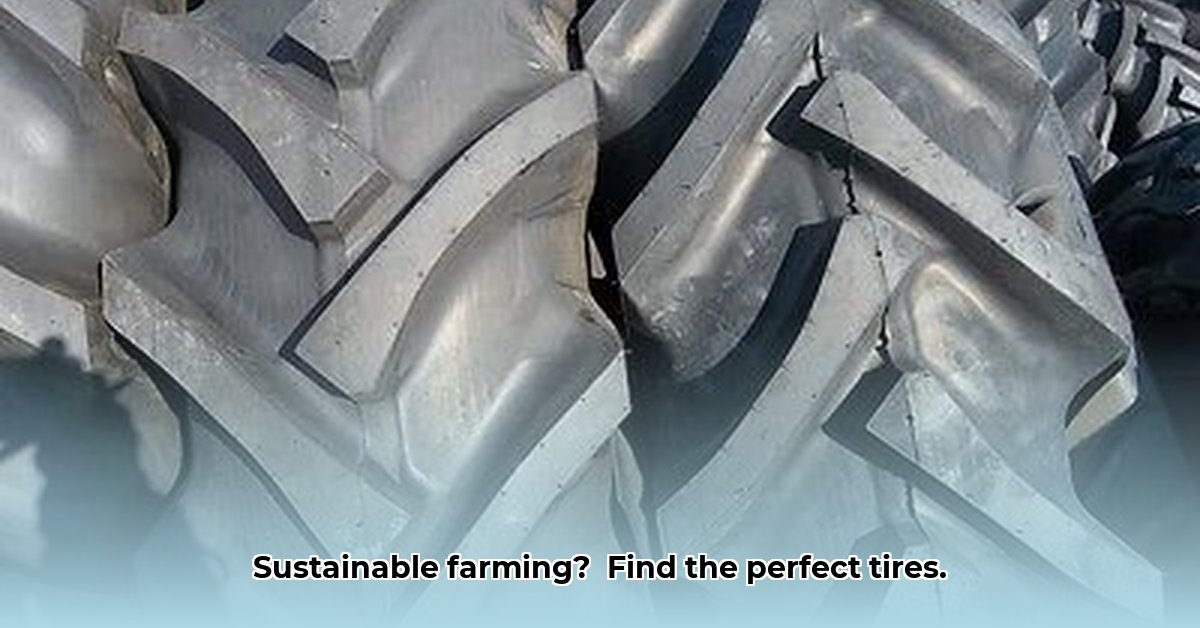
Finding the perfect 16.9 x 30 tractor tires is crucial for efficient and sustainable farming. This guide helps you navigate the choices, balancing cost with long-term performance and environmental impact. We'll compare budget and premium options, offering a practical framework for decision-making. For more tire options, check out our guide on larger tractor tires.
Understanding the Importance of Tire Selection
Your tractor tires are a significant investment impacting fuel efficiency, soil health, and overall farm profitability. The right tires minimize soil compaction, reduce fuel consumption, and enhance traction for improved yields. Choosing wisely ensures long-term savings and contributes to sustainable farming practices. Don't underestimate the impact; the right tires can significantly increase your bottom line.
Deciding on the Right Tires: A Practical Checklist
Before diving into specifics, consider these factors:
Budget: Premium tires, while pricier initially, often offer superior longevity and fuel efficiency, leading to cost savings over their lifespan. Carefully weigh the initial investment against long-term potential returns. A cost-benefit analysis is essential.
Soil Type: Sandy soils require different tire characteristics than heavy clay or rocky terrain. Aggressive lug patterns excel in mud but can increase soil compaction; lighter treads are gentler on sandier soils. No-till farming benefits from tires minimizing soil disturbance. What type of soil do you primarily work with?
Farming Practices: No-till farming, a sustainable practice minimizing soil disruption, requires tires that reduce compaction. Wider contact patches are generally preferable. Conventional tillage may allow for more aggressive tread patterns. What are your primary farming practices?
Comparing Tire Options: Budget vs. Premium
Direct comparisons between budget and premium 16.9 x 30 tires are difficult due to the absence of universally standardized testing. The following comparison uses relative terms and acknowledges the limitations:
| Feature | Budget Tire | Premium Tire (e.g., Firestone Super All Traction II or equivalent) |
|---|---|---|
| Initial Cost | Lower | Higher |
| Tread Life | Shorter | Significantly Longer |
| Fuel Efficiency | Lower | Noticeably Better |
| Traction | Adequate in ideal conditions; may struggle in challenging soil conditions | Superior grip in various conditions |
| Soil Compaction | Higher | Lower |
Important Note: These are generalizations. Performance varies with factors such as operating conditions and maintenance. The frequently advertised "Easy Test Score" is a proprietary metric, not a standardized industry benchmark. Focus on observable characteristics like tread depth, lug angle, and contact patch area for meaningful comparisons. Consider seeking independent reviews and conducting your own assessments where possible.
Long-Term Cost Analysis: The Total Cost of Ownership
A comprehensive cost analysis considers more than just the initial price. The following table illustrates a hypothetical five-year comparison (actual costs vary based on usage and local pricing):
| Tire Type | Initial Cost | Estimated Fuel Savings (5 years) | Estimated Lifespan (years) | Estimated Repair Costs (5 years) | Estimated Total Cost of Ownership (5 years) |
|---|---|---|---|---|---|
| Budget Tire | $500 | $200 | 3 | $100 | $800 |
| Premium Tire | $800 | $600 | 5 | $50 | $750 |
This example highlights how a higher upfront cost can translate to lower overall costs over the tire's lifespan due to fuel savings and extended service life. Remember, this is a hypothetical example; your specific costs will vary. Conduct a detailed analysis using your specific farm's operational data.
Maintaining Your Tires: Practical Tips for Extended Lifespan
Proper maintenance is essential for maximizing tire life and performance:
Regular Pressure Checks: Underinflation increases wear and reduces fuel efficiency. Overinflation can also cause damage. Consult your tractor's manual for the correct inflation pressure and check regularly.
Frequent Inspections: Regularly inspect your tires for cuts, embedded objects, and signs of damage. Address any issues promptly.
Periodic Rotation: Rotating your tires ensures even wear, prolonging their lifespan. Consult your tractor's manual for the appropriate rotation schedule.
Proper Storage: When not in use, store tires in a cool, dry place, away from direct sunlight and extreme temperatures.
Conclusion: Making the Right Choice for Sustainable Farming
Selecting the right 16.9 x 30 tractor tires is a critical investment impacting your farm's profitability and environmental sustainability. This guide provides a framework for making an informed decision. Remember to consider factors such as budget, soil conditions, farming practices, and the total cost of ownership over the tire's lifespan. A well-informed choice contributes to both economic efficiency and environmental stewardship.